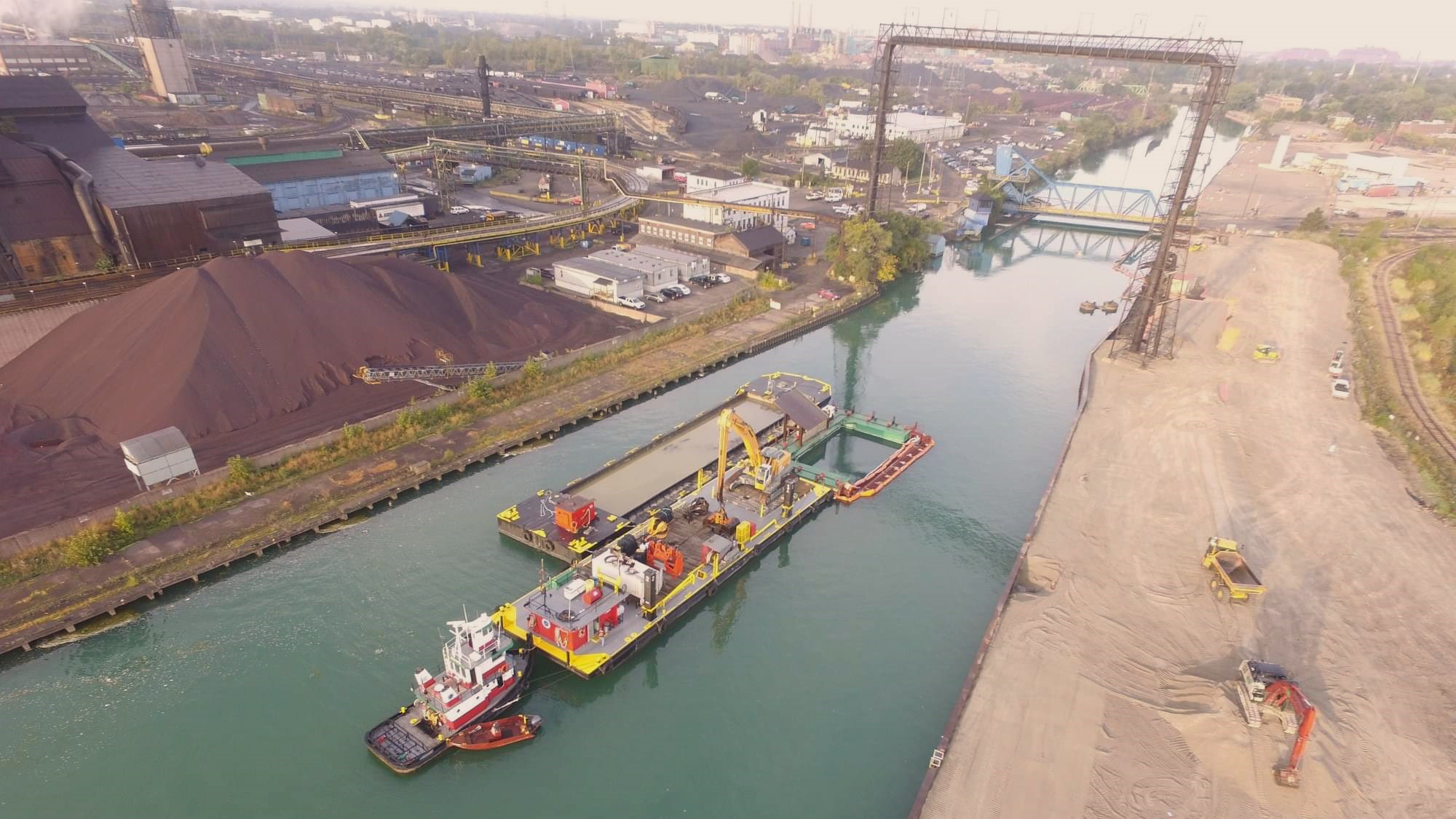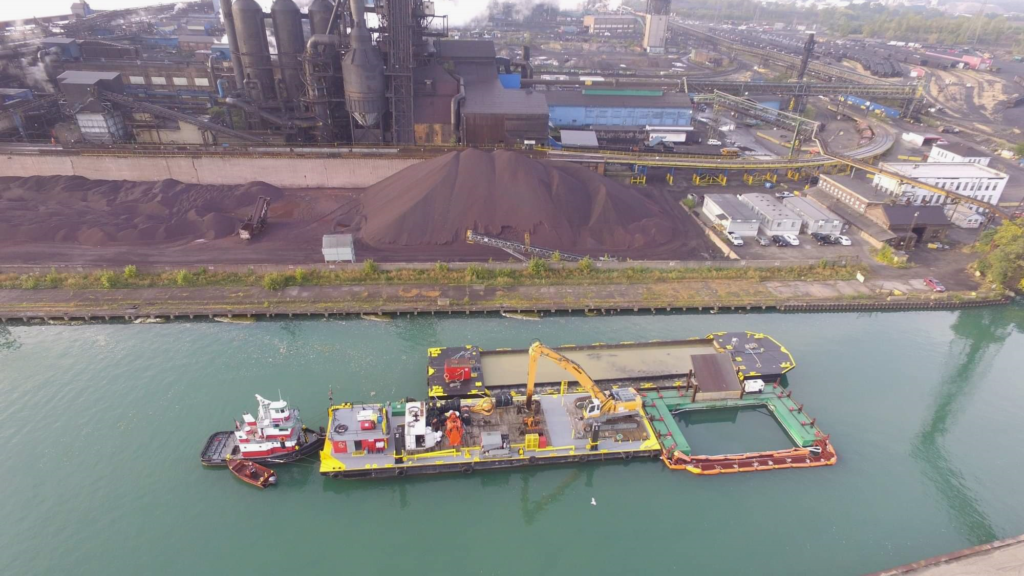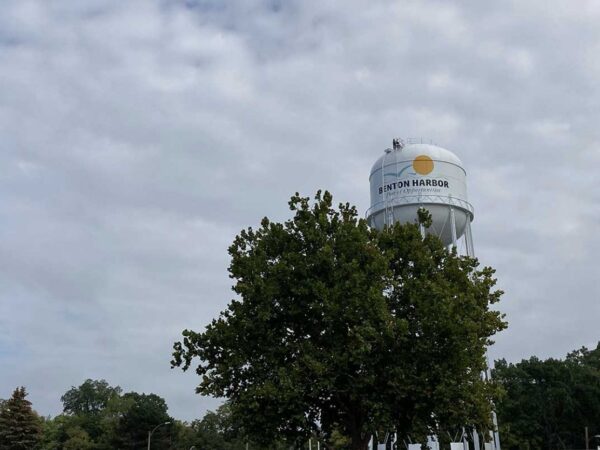
Great Lakes Moment is a monthly column written by Great Lakes Now Contributor John Hartig. Publishing the author’s views and assertions does not represent endorsement by Great Lakes Now or Detroit Public Television.
Not many people know the history of Zug Island at the confluence of the Rouge and Detroit rivers, nor the $50 million project currently underway there.
The island is named after Samuel Zug, who came to Detroit from Pennsylvania in 1836 as a 20-year-old. He went into the furniture-making business with a Detroit investor named Marcus Stevenson with money he had saved as a bookkeeper in Pittsburgh. The substantial forests and convenient access to East Coast markets by way of the Detroit River, Great Lakes and the Erie Canal made Detroit an ideal place for a young man seeking a fortune making furniture.
After 23 years in the furniture business, his partnership with Stevenson dissolved in 1859, leaving Zug a wealthy man. He purchased 325 acres of land at the confluence of the Rouge and Detroit rivers from Michigan’s second territorial governor, General Lewis B. Cass. It was a marshy peninsula that was three-quarters wetlands. Another attractive feature was that it had a natural sulfur spring that was providing, at that time, 1,200 barrels of mineral water per day.
Zug and his wife had hoped to build a mansion on the island, but after ten years they decided that the wetlands and the mosquitos breeding there were just too much to endure.
In 1888, Samuel Zug authorized the River Rouge Improvement Company to cut a small canal 60 feet wide and eight feet deep along the south end of his land, essentially converting his natural peninsula into a human-made island and making a new river mouth south of where the Rouge River used to empty into the Detroit River. This reversed the flow of the Old Channel. Detroit River water now flowed into the Old Channel, around the island, and then mixed with Rouge River water before emptying again into the Detroit River.
In 1889, Samuel Zug died, leaving this land to his wife, who died in 1891. The Zug heirs sold the island for $300,000 to George Brady and Charles Noble, who wanted to use it for industrial development. Today, it is called Zug Island and has a more-than-100-year history as part of the epicenter of the industrial revolution in Detroit. Several blast furnaces for steel production were built on the island beginning in 1902.
In the early 1900s, Henry Ford enlarged the canal to accommodate large freighters bringing raw materials into the Ford Rouge Plant. This shipping channel extends from the Detroit River at Zug Island upriver to a turning basin for freighters in Dearborn where the Rouge Plant is located. Construction of the Rouge Plant began in 1917 and was completed in 1928, making it the largest integrated factory in the world at that time.
Before strong environmental laws were enacted in the 1970s, pollutants were routinely discharged into the lower Rouge River. Dozens of industries operated in the area from the late 1800s, including iron and steel mills, coking plants, and tar and paper manufacturing. Today, there are strict controls on pollutant discharges, but the legacy of many decades of release of pollutants into the river can be found in contaminated sediments.
It should be no surprise that the Old Channel was identified as a contaminated sediment hot spot. The primary contaminants of concern in the Old Channel are polynuclear aromatic hydrocarbons that are known to cause liver tumors in fish and oil and other petroleum products. An industrial chemical called polychlorinated biphenyls or PCBs is also present.
Incidentally, the oil and other petroleum products in the sediments are undoubtedly the same kind of oil products that caused the infamous Rouge River fire 50 years ago.
In 2018, a voluntary contaminated sediment remediation project was started on a 0.75-mile stretch of the Old Channel under the Great Lakes Legacy Act. The Old Channel is part of the Rouge River Area of Concern. The first step was stabilizing the river bank along the Old Channel.
In 2019 and 2020, dredging and disposal of contaminated sediments and capping of contaminated sediments where dredging is not possible due to underwater utilities and other hazards are being carried out.
In total, 70,000 cubic yards of contaminated sediment is being remediated at a cost of $50 million. The contaminated sediments are being transported by barge for disposal at the U.S. Army Corps of Engineers’ Pointe Mouillee Confined Disposal Facility in South Rockwood, Michigan. Silt curtains are deployed in the water around the dredging to minimize any suspended sediment from leaving the site.
Following the contaminated sediment remediation, spawning habitat will be enhanced for locally important fish species like walleye and lake sturgeon.
Benefits of the project include:
- Removal of heavily contaminated sediments that are impacting invertebrate species living on the riverbed and contaminating fish and wildlife
- Removal of large debris from the Old Channel, including over 30 cars, telephone poles and large concrete sections of old foundations, which will improve safety for recreational boaters and other users
- Stabilization of the river bank will reduce erosion and improve aesthetics in the Old Channel
- Creation of spawning habitats for regionally important fish species
This project is unique because it is a partnership between the U.S. Environmental Protection Agency and Honeywell Inc. Although many industries contributed to the contamination of sediments in the Old Channel and a number of them no longer exist, Honeywell Inc., which now owns the Detroit Coke property (one of the original sources of the pollution), is voluntarily contributing more than $20 million to this Old Channel sediment cleanup.
The balance is coming from the Great Lakes Legacy Act. This 2002 Act allows the EPA to partner with private entities to clean up and restore Great Lakes Areas of Concern.
Discussions and planning began in 2010, with the cleanup and restoration occurring in 2018 to 2020. It is a more streamlined approach to federal cleanup of contaminated sediments. Through the Great Lakes Legacy Act, the EPA pays up to 65 percent of the approved project cost. A minimum of 35 percent of the approved project cost must come from a non-federal partner.
The idea is that the federal incentive of 65 percent of the cost of the approved sediment cleanup project will be motivation for companies to come to the table voluntarily and avoid protracted litigation that can take substantial time and increase the total cost of the project. The intent is to accelerate sediment cleanups and have more money go into sediment remediation and less into litigation.
This Old Channel sediment cleanup project is critically important to restoring the Rouge River Area of Concern. As a successful example of public-private partnership to clean up contaminated sediments, it is also critically important to remediation of contaminated sediments in the Detroit River Area of Concern.
Recently, the EPA and the Michigan Department of Environment, Great Lakes, and Energy have identified 6.7 million cubic yards of contaminated sediment that requires remediation at nine locations along the U.S. shoreline of the Detroit River to restore beneficial use impairments. The EPA and EGLE are now identifying and seeking industrial partners to undertake necessary remediation of these remaining contaminated sediments in the Detroit River, similar to the Rouge River Old Channel.
Samuel Zug never lived long enough to see the industrial development of his island, but there is no doubt that he would be pleased to know that his old channel is being cleaned up for fish, wildlife and all of us, because we live in the same ecosystem!
Great Lakes Now contributor John Hartig is a board member at the Detroit Riverfront Conservancy. He serves as the Great Lakes Science-Policy Advisor for the International Association for Great Lakes Research and has written numerous books and publications on the environment and the Great Lakes. Hartig also helped create the Detroit River International Refuge, where he worked as the refuge manager until his retirement.
Featured Image: Contaminated sediment remediation is underway at the Old Channel of the Rouge River off Zug Island, Photo courtesy of U.S. Army Corps of Engineers, Detroit District
1 Comment
-
Great news and great article!!!!





